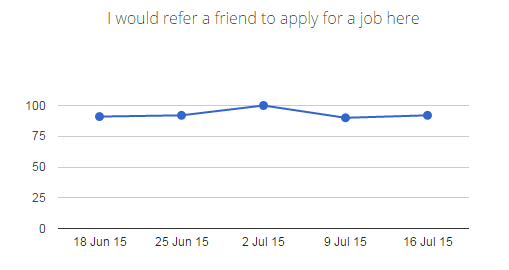Across the globe, there is a large and growing interest from organisations in adopting employee pulse surveys. So what are they exactly, and what benefits can you expect to receive from using them? What should you ask before you start, and what makes a successful survey?
Employee pulse surveys are a relatively recent phenomenon, gaining interest from companies both big and small, across a wide range of industries in many countries in the last five years or so. There’s a reason for this healthy uptake; pulse surveys are highly effective in helping steer and improve the course of your organisation.
In this article, we’ll explain;
- What are employee pulse surveys
- The history of employee surveys
- Benefits of using employee pulse surveys
- Frequently asked questions about pulse surveys
- Questions to consider when choosing employee pulse survey software
- 7 Steps to a Successful Pulse Survey
The relative ease of setting up, the fast response rates and quick feedback cycles are commonly understood benefits of these surveys. Let’s begin by understanding what they are.
What are employee pulse surveys?
An employee pulse survey is a fast and frequent survey system, that does away with complex questions and is intentionally designed to be done weekly, or every few weeks. They give a quick insight into the health of a company, hence the name ‘pulse’.
Thanks to technology, an employee pulse survey can be done securely over the Internet, rather than using paper or custom in-house survey software. The benefit here with ‘cloud software’ is that it is typically improved constantly, and there may be new features coming in the months ahead.
History of employee surveys
Whilst pulse surveys are considered quite ‘young’ in business circles having been around for only 5-8 years, employee surveys on the other hand, have been utilised for around a century. The first employee surveys, called “employee attitude surveys”, surfaced in the 1920’s in successful industrial companies.
The increased awareness in measurement tools regarding employees’ attitudes is attributed to research and observation conducted during World War II, which sought to measure morale and replicate high-morale environments.

Benefits of adopting employee pulse surveys
There are many known benefits of employee pulse surveys, mostly found in employee engagement, improved company culture, and the like. The benefits, in detail, include;
Near real-time measurement of employee engagement and satisfaction
Receiving feedback so often and so quickly means that you are getting an insight into morale and employee satisfaction at the moment, not reviewing a survey which has collected data for weeks a month or so after the polls closed.
Improved employee engagement
Asking your team for regular feedback encourages positive employee engagement. Employee engagement is a very important topic these days, because the research has clearly shown that it has huge organisational benefits.
Studies have repeatedly shown benefits of employee engagement, include;
- Engaged employees are more productive and take less time off
- Engaged employees make customers happier
- Employee engagement leads to an increased productivity
- Engaged employees perform at a higher level and bring passion and interest to their job, which often leads to innovation in the workplace
- Employees who are engaged significantly lower the risk of turnover for the company
- Companies with more engaged employees tend to have higher profitability rates
Measuring employee engagement is no longer an afterthought for many successful companies. Companies such as Apple, Etsy, Airbnb, Microsoft and Amazon are using employee pulse surveys to measure engagement levels amongst their teams.
To find out more, read The definition of employee engagement.
Pulse surveys increase positive company culture
A culture of asking for employee feedback creates happier, more engaged employees, which in turn, increases positively in corporate culture.
Many employees cite negative company culture as a reason for changing jobs, so there are great benefits for having a positive company culture. This article shows that bad company culture costs US$26.7 billion for UK companies annually.
Encourages employees to focus on topical subjects
Studies have proven that if someone was asked about a particular topic week after week, the habit-forming nature of this activity means that they will be more aware of this topic during the other six days of the week.
As an example, perhaps you asked a survey question each time around customer service; it will only take a few weeks for employees to start considering ways to improve customer service between each poll.
Repetitive questions over a longer period of time have been proven to be an effective method of forming positive habits.
Employee pulse surveys provide powerful motivation insights
Asking the right questions will ensure that you get a deep understanding of employee motivation – what is the current mood of the company and where are the motivational triggers? Armed with this information, leadership can work on improving the motivation of their teams using these insights.
They allow for analysis of improvements over time
Most employee pulse survey reports feature some form of statistical analysis and trend graphs. Looking at how responses were affected after major or minor internal events, or during times of change is a powerful insight into employee motivation and morale.
Say you asked a question about physical working conditions, and then had the office kitchen remodeled. You can use a pulse survey to see what the effect of this change during and after the work was carried out, was.

Image: Employee pulse survey trend graph
Frequent reminder that management values employee feedback
By asking for employee feedback frequently, you are illustrating through your companies actions that you care about employee feedback.
Studies have shown that a large percentage of people value leaders who ask for feedback, and by doing so, this generates great morale and happiness.
Pulse surveys can be a powerful employee relations tool
Simply by asking for employee feedback, you are improving employee relations between management and workers.
Employee relations are improved knowing that your voice is being heard and that you have the right to ‘speak up’. For many companies, leaders see pulse surveys as a way to start conversations with individual employees and teams on improving morale.
Reduced time in completion
Unlike the traditional annual employee survey that an organisation may use, these pulse surveys are intentionally fast to complete, reducing the traditional financial and time costs for organisations to survey their staff.
For example, the typical completion time for recipients of 6Q surveys is around 90 seconds (based on over 1,100 employees in a number of companies). If an organisation had a survey cadence (frequency) of every two weeks, this means that each employee spends less than hour per year completing these surveys.
Higher response rates than annual employee surveys
Because of the simplicity of completing team pulse surveys, and the time factors mentioned above, many companies find that they have far higher response rates with all or most employees completing these pulse surveys every poll period, compared to the traditional annual employee survey.
We have frequently seen staff survey response rates in the 85%+ area, which is no mean feat when it comes to surveys. For example this article states an average response rate for internal facing surveys, is approximately 30-40%.
Encourages open communication
Using an employee pulse survey helps create an environment of open communication, and encourages employees to feel motivated to share suggestions and make recommendations for improvements.
This helps clarify expectations, increases knowledge sharing and creates an environment of innovation.
Helps direct future employee engagement activities
Measuring employee engagement under one initiative will give you comprehensive feedback that allows you to conduct an in-depth analysis. In turn, that information can be leveraged to implement effective action plans, which act as crucial tools to improving overall engagement.
Encourages employee happiness
People are known to be happier when they have had the mechanism to ‘have their say’. Studies have shown that happier employees are more productive, meaning that companies with happier employees tend to fare better financially and from a morale perspective.
Research has shown employees who identified themselves as happy in their positions are productive 80 percent of the time at work. Comparatively, employees who identified themselves as unhappy were only productive 40 percent of the time.
– American Business Magazine
For more, read our blog post, Benefits of increased job satisfaction.
Improves employee health
As with productivity, scientific studies have shown that happiness is linked directly to employee health. As a result, it isn’t far-fetched to assume that improving employee happiness will encourage physically healthier employees.
For example, a 2012 study, in the scientific journal, Applied Psychology, is the most comprehensive review so far of the evidence linking happiness to health outcomes. A review of more than 160 studies of human and animal subjects has found “clear and compelling evidence” that – all else being equal – happy people tend to live longer and experience better health than their unhappy peers.
A 2012 review of more than 200 studies found a connection between positive psychological attributes, such as happiness, optimism and life satisfaction, and a lowered risk of cardiovascular disease.
– Psychological Bulletin.
Provides detailed information collection
By surveying every employee within your organisation you will gain a more accurate and comprehensive insight into employee attitude and engagement, which will allow you to better assess the strengths and weaknesses of your company.
These are just some of the many fantastic benefits of adopting an employee pulse survey for your organisation.

Image: Angie Garrett, Flickr
Frequently asked questions about pulse surveys
Naturally, many managers have a list of questions before undertaking employee pulse surveys. Here are some of the most common questions we’re asked.
Are employee pulse surveys designed to replace traditional annual surveys?
Not necessarily – annual surveys often have far more detailed responses however they tend to also have less response rate and take far longer, therefore are typically much more expensive. For further information, read our blog post 5 great reasons why your annual employee survey sucks.
How should I use the survey results?
You should review the results, and look for actionable opportunities from them; at the very least, you can bring up any concerns you have with your team, and discuss ways to address them.
The last thing you want to do, is do nothing. This style of survey is most effective when managers take reasonable actions as a result of the staff feedback.
How frequently shall I send a pulse survey?
We recommend that organisations do them weekly, however we understand that some may find this too frequent. No less frequent than monthly, and no more frequently than weekly is our recommended survey frequency.
The majority of our current customers are sending their 6Q polls every two weeks. Given the speed in which employees can answer them, this is a very small time consideration.
What response rates shall I expect?
Typically, most pulse surveys enjoy a very high response rate, of 90-100%. This is dictated by the situation though; so ensure you ask your entire organisation, and make note to explain why the surveys are being adopted, and how you expect to enact on the feedback.

Image: Sebastiaan ter Burg, Flickr
Questions to consider when choosing employee pulse survey software
If you have made the decision to adopt an employee pulse survey within your business, great! Now you need to consider which software vendor to choose.
Here are a few questions to consider when making that choice.
Are the response screens mobile friendly?
With statistics showing mobile internet use now catching up to desktop use in many countries, it is important that whatever survey you choose allows for participants to answer on their phones or tablet devices.
In 2019, we often see that mobile devices are actually a higher device rate than laptops or desktops for completing our pulse surveys. If the survey itself is not mobile friendly, this will frustrate employees, and lead to lower response rates.
Do they ask for anonymous, individual responses or both?
Ideally, you would have the option of doing either. Whilst anonymous is great, many companies find that as their company culture improves, employees are readily completing identifiable surveys just as honestly.
Do they allow for custom questions or is their survey tool “one-size fits all”?
You will want to find a vendor that provides a good survey question library to provide value, however there may be times when you want to ask a specific, custom question. This should be allowable without additional costs or set-up.
Do they have comprehensive but easy-to-understand reports?
Whilst the survey screens may be easy to complete, what are the reports like to understand and share? If they are heavily technical or difficult to assess, you will waste precious time and effort trying to get insights from them.
Is the interface easy-to-use?
You will want to ensure that the actual survey itself is very easy to complete – if a survey takes twice as long due to a confusing interface, this could add significant staff costs over a year. For example, the difference between 150 staff taking 2 minutes (5 hours total) versus 5 minutes, is 7.5 hours, so 12.5 hours total. If they were paid $50,000 per year, and you did the pulse survey every two weeks, that adds up to a whopping $4,689.75 per year*.
($50,000 per year equates to $24.05 per hour x 7.5 hours x 26 polls)
Is the survey secure?
Most vendors use secure certificates (SSL) to protect the data and responses from prying eyes. What else does the vendor do, to protect your employee information and their responses?
To secure data, you need to go with a proper SSL certificate available at a low price in the market. It is wise to have SSL from reputed authorities like Comodo SSL certificate, RapidSSL certificate, and Digicert SSL certificate.
Has the vendor got a good up-time and solid backup/disaster recovery processes?
You should always check that the survey provider is hosted on dedicated high-capacity servers and is regularly backing up all the data. For example, we have a public status page that shows the performance of our main services (My 6Q is our actual service).
What additional features will it provide?
Does the vendor have additional features in their survey software that you may wish to use at a later date? For example, some vendors have peer to peer employee recognition features, which are a great way to encourage your employees to thank each other for great work.
See our blog post, Introducing our peer-to-peer employee recognition feature.
What are the full implementation costs?
Ensure you compare the full costs, and not just the advertised ‘per user’ or ‘per month’ costs. Some vendors may advertise a low monthly fee, and then charge a significant set-up or exit cost as well. In an ideal situation, you would pay a monthly fee with no contractual arrangements in the mid to long term. Always check the fine print is a good motto to remember.
Remember also that expensive doesn’t necessarily mean ‘better’ – compare features and answers to the above in context, don’t just choose the vendor based purely on price.
Best of luck in choosing the right survey vendor!
7 Steps to a Successful Employee Pulse Survey
To have a successful result, we recommend that you follow these seven steps in delivering your employee pulse survey.
Choose the questions you will ask
Most vendors offer a library of pre-written questions, as well as the ability to create custom questions based on your requirements. You should choose between 4-10 questions that cover a wide spectrum of areas, such as happiness, motivation, feelings about management and workload or work/life balance. Ensure the questions aren’t ‘leading’ or overly vague.
We find that more than ten questions results in survey fatigue, where employees start clicking next or leave the default response in, as a way to hurry up and get the survey complete.
Announce the survey to the organisation
You want to minimise the sudden shock that employees may receive getting an unsolicited email with a link to some pulse survey they have never heard about. You have to prepare and announce your pulse surveys carefully, to ensure good response rates. This is best as an organisation-wide email from the CEO, or a discussion point at your next all hands meeting.
Start the survey
Before starting the first survey, you want to consider the frequency you are going to survey employees, and the most suitable day and time to ask. For example, asking at the start of the work week may not be ideal, nor is it ideal to ask on a weekend. We find many companies send them mid week, to get a real sense of what the mood is like, ‘in the trenches’.
Analyse the responses
Once the pulse survey is complete, make it a standard habit to review all of the responses in detail and look for common areas of concern or ‘positive wins’ to reflect on. The worst thing a manager can do, is ignore the results entirely. In this situation, it is better to not run them at all, than to ask employees to complete them, and then discard their efforts.
Share the survey
Many organisations share the results of their surveys with the entire team, whilst others share the reports only with direct managers or the leadership team. It’s important to share both ‘good’ and ‘bad’ responses, although we see all feedback as positive in it intent.
Take action!
This is the most important step. If you are collecting employee feedback and doing nothing with it, this can be far worse than not asking at all. It is very dispiriting for employees who spend time responding to surveys, to find that nothing happens as a result; this often makes people feel ignored and not valued.
Review and repeat
One of the great things about staff pulse surveys is that you continue to do them. Send the survey again, and see what effect any actions you’ve done in the step before have made to the team.
In Summary
Employee pulse surveys allow for organisations to undertake employee engagement and monitor team sentiment without the traditional costs or effort involved. Companies across the globe are taking a more ‘agile’ approach to collecting feedback form thei employees, without the typical costs of the traditional annual employee survey.
The main benefits outlined, are;
- Near real-time measurement of employee engagement and satisfaction
- Improved employee engagement
- Pulse surveys increase positive company culture
- Encourages employees to focus on topical subjects
- Employee pulse surveys provide powerful motivation insights
- They allow for analysis of improvements over time
- Frequent reminder that management values employee feedback
- Pulse surveys can be a powerful employee relations tool
- Reduced time in completion
- Higher response rates
- Encourages open communication
- Helps direct future employee engagement activities
- Encourages employee happiness
- Improves employee health
- Provides detailed information collection
As well as these features, we’ve answered some frequently asked questions, suggested some questions to consider when choosing employee pulse survey software, and taken you through seven steps for a successful roll-out.
Best of luck in choosing the right team survey system for your needs, and well done on being committed to improving employee satisfaction and building employee engagement!




